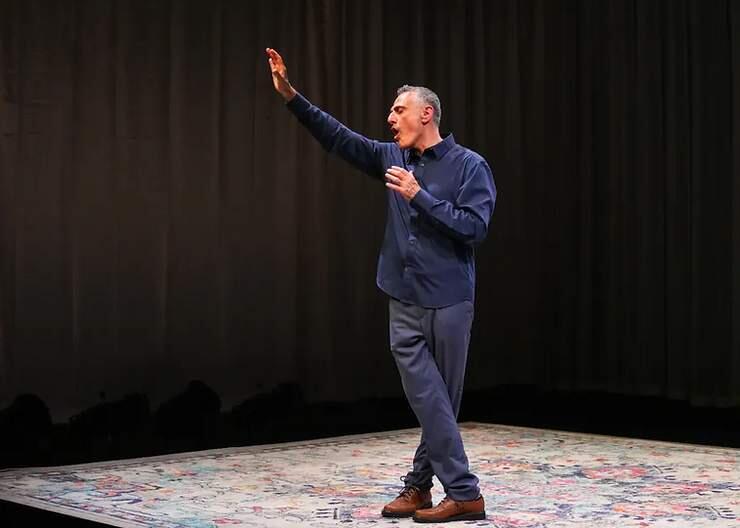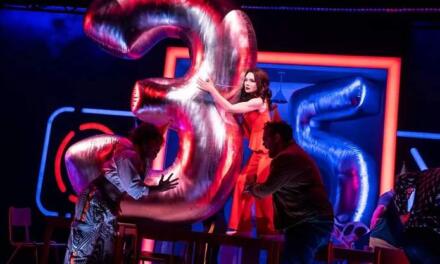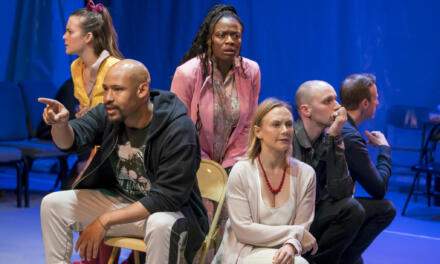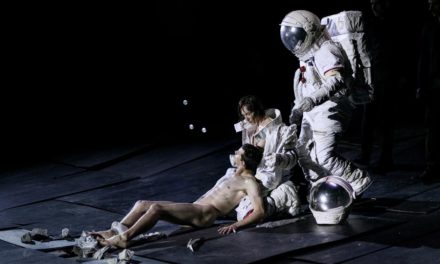The opera Four Saints in Three Acts’ astonishingly successful run on Broadway in 1934 was the most celebrated avant-garde theater triumph of its age. With a libretto by Gertrude Stein that told no coherent story, a polymorphous score by Virgil Thomson that channeled everything from glee club tunes and children’s ditties to Gilbert and Sullivan, filigreed sets by Florine Stettheimer made of cellophane, and an all-Black cast of 22 singer-dancers recruited from Harlem’s Savoy Ballroom, the show was a huge, defiantly whimsical modernist spectacle that baffled ordinary audiences enjoyably enough to become a hot commercial ticket. Overnight it transformed Stein from a literary joke into a bestseller (The Autobiography of Alice B. Toklas had been published 6 months earlier) and brought Thomson the serious recognition long denied him. It was the mainstream arrival of two important, long-marginalized artists.
More. In the decades that followed, Four Saints became the classical touchstone for every American theater avant-gardist planning an ambitious musical extravaganza, from Julian Beck and Judith Malina to Philip Glass, Robert Wilson, The Wooster Group, Richard Foreman, and Lee Breuer. All of them considered Stein and Thomson their godparents.
How fascinating and jarring it is, then, to see Four Saints as a solo show in a remote warehouse in bleak industrial Brooklyn, embraced by an American avant-gardist as a very different sort of minimalist touchstone. Four Saints is the final part of David Greenspan’s trilogy of plays from the 1920s, all performed as solo works (following The Patsy in 2011 and Strange Interlude in 2017). Heroically, amazingly, he performs Stein’s maddeningly repetitious, disconnected, and opaque libretto as a spoken text, without Thomson’s score—a feat of memorization so impressive it turns into one of the project’s most compelling features.
Dressed neatly in blue slacks and a button-down shirt, standing on a worn ornate carpet atop an elegant, plinth-like platform, Greenspan speaks Stein’s words with sparkling clarity, grouping sentences and phrases together as a gifted storyteller would to make characters and fictional circumstances clear. The thing is, Four Saints contains no consistently drawn characters or connected storylines. It is an anticly self-reflexive, willfully disjointed text that teases us with the possible introduction of such theatrically grounding elements as character development and plot line, only to contradict, deny or dissolve them soon after. Greenspan’s eminently sensible delivery, then—changing voices for different speakers, grouping lines as conversational exchanges, using hand gestures to indicate spatial locations—amounts to a 90-minute MacGuffin.
He does (like Virgil Thomson) find much musical beauty in Stein’s lines, presumably with the help of his director Ken Rus Schmoll. Some sequences rise to inquisitive lilts like woodwind trills, for instance, others meander up and down like elusive melodies, still, others startle with rat-a-tat repetition like percussion cadenzas. Yet any promise of coherent organization or structure these effects might hold out is false. The work remains what it always was: a hermetic document of self-absorbed language-play by an author utterly uninterested in either the theater or fictional action beyond speech acts.
It was Virgil Thomson’s savvy, pluck, and professional connections—as well as a fantastical quirk of cultural timing—that made this stubbornly self-absorbed author a celebrity. (Steven Watson analyzes the cultural moment brilliantly in his book Prepare for Saints: Gertrude Stein, Virgil Thomson, and the Mainstreaming of American Modernism.) Stein would never have achieved stardom on her own and it never did lead to other new triumphs in the theater. The production record for all of her plays, including this one, is meager to this day.
With this fiercely idiosyncratic, extraordinarily disciplined solo show, then, David Greenspan has returned Stein to her roots, to the essence of who she always was as a playwright. And I mean that as a compliment. The 1934 production of Four Saints was a unicorn, a distracting anomaly in her history. Greenspan’s project—bizarre, difficult, and lonely as it seems—touches the hermetic core of Stein. And that is the prime reason why it’s so moving. The mind and heart of that inaccessible poet, whose every brittle pun and insular non-sequitur defied intimate approach, opens up to us through the vessel of Greenspan’s remarkable passion.
Four Saints in Three Acts
by Gertrude Stein
Directed by Ken Rus Schmoll
Produced by Lucille Lortel Theatre at
The Doxsee @ Target Margin Theater
232 52nd St., Brooklyn
This article was originally published by riginally Theater Matters on September 21, 2022, and has been reposted with permission. To read the original article, click here.
This post was written by the author in their personal capacity.The opinions expressed in this article are the author’s own and do not reflect the view of The Theatre Times, their staff or collaborators.
This post was written by Jonathan Kalb.
The views expressed here belong to the author and do not necessarily reflect our views and opinions.


















